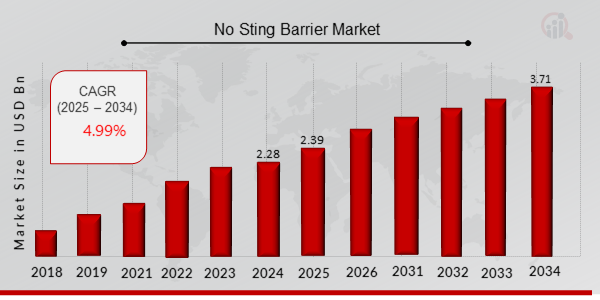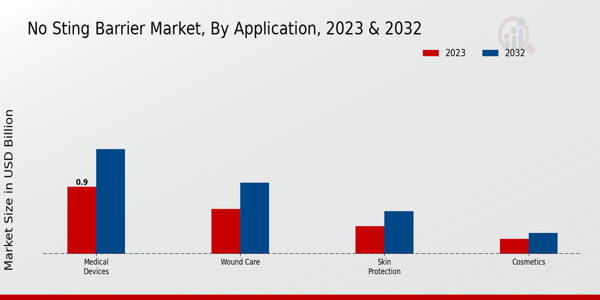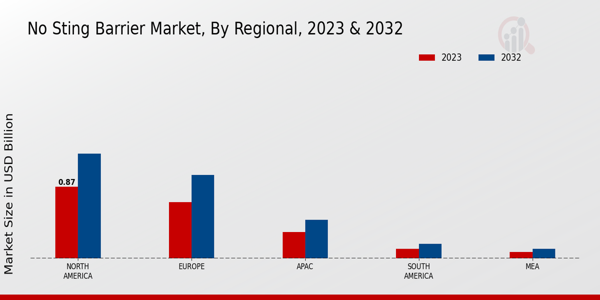No Sting Barrier Market Overview
As per MRFR analysis, the No Sting Barrier Market Size was estimated at 2.28 (USD Billion) in 2024. The No Sting Barrier Market Industry is expected to grow from 2.39 (USD Billion) in 2025 to 3.71 (USD Billion) till 2034, at a CAGR (growth rate) is expected to be around 4.99% during the forecast period (2025 - 2034).
Key No Sting Barrier Market Trends Highlighted
The No Sting Barrier Market has been shaped by several key market drivers. Increasing awareness about skin sensitivity and the need for protective solutions in various healthcare settings is fueling demand for no-sting barrier products.
Additionally, rising incidences of skin-related issues, including allergies and irritations from adhesives, are propelling the need for effective skin protection. The growing geriatric population, which often requires assistance in daily activities, is another significant driver as caregivers seek to provide safe and comforting options for their patients.
This has inevitably led to a rise in market interest as both medical professionals and patients prioritize skin health. There are numerous opportunities to be explored within this market. Innovations in product formulations and technology present a chance for companies to create more effective and user-friendly no-string barrier products. Expanding the range of offerings to cater to specific skin types or conditions could capture a broader customer base.
Additionally, increasing distribution channels, including e-commerce and direct-to-consumer models, can help companies reach a wider audience. Manufacturers that build partnerships with healthcare providers may also find opportunities to enhance visibility and credibility in the market. Recent trends in the no-string barrier market reflect a shift towards natural and hypoallergenic ingredients.
Consumers are becoming more health-conscious and are more inclined to choose products that are free from harmful chemicals. This has driven brands to innovate and promote formulations that emphasize safety and skin health.
Moreover, as personal care becomes more integrated with wellness, the demand for multifunctional products that provide barrier protection while also nourishing the skin is on the rise. The focus on sustainable practices is yet another emerging trend, leading to eco-friendly packaging and formulations being increasingly favored by consumers. Ultimately, these trends highlight a dynamic market landscape that prioritizes health, safety, and sustainability.

Source: Primary Research, Secondary Research, MRFR Database and Analyst Review
No Sting Barrier Market Drivers
Increasing Demand for Skin Protection Products
The No Sting Barrier Market Industry is experiencing a notable surge in demand for skin protection products. As consumers increasingly recognize the importance of skin health and the prevention of irritation or allergic reactions from various products, the market for no-sting barriers is seeing significant growth. Factors such as rising awareness of skin allergies, the prevalence of various skin conditions, and a growing preference for protective solutions that do not cause discomfort, particularly among sensitive populations, including children and individuals with specific medical conditions, are contributing to this trend.
Further, sectors like healthcare are enhancing the patient’s experience and security, thus heightening the utilization of no-sting barriers for wound care and other medical procedures. It is also worth mentioning that a growing number of elderly people are boosting the consumption of such items as they often need more extensive coverage to handle delicate skin. The rise of e-commerce and increased consumer access to a variety of skin care products are further propelling the No Sting Barrier Market Industry, leading to innovations and a diverse range of offerings tailored to meet specific consumer needs.This trend is expected to continue as more consumers seek out products that offer both protection and comfort, allowing the no-sting barrier market to solidify its position within the broader skin care industry.
Technological Advancements in Formulation
The No Sting Barrier Market Industry is benefiting from continuous technological advancements in product formulation. Manufacturers are developing more effective, non-irritating formulations that cater to diverse consumer needs. By incorporating innovative ingredients and improved application techniques, companies are enhancing product efficacy while ensuring a gentle experience for users. These developments are crucial in attracting consumers who are looking for high-quality, reliable protective solutions.As competing products evolve, the focus on research and development becomes imperative for companies aiming to thrive in the market.
Rising Awareness of Hygienic Practices
There is a growing emphasis on hygiene and sanitation practices worldwide, which contributes significantly to the expansion of the No Sting Barrier Market Industry. Consumers are becoming more conscious of germs and bacteria, leading to an increased demand for protective solutions that ensure cleanliness while minimizing discomfort. This awareness fosters a more extensive adoption of no-sting barriers, especially in healthcare settings and among consumers opting for personal care products that prioritize skin protection.As public health initiatives continue to promote hygiene, the market is expected to see consistent growth.
No Sting Barrier Market Segment Insights
No Sting Barrier Market Application Insights
The No Sting Barrier Market's Application segment reflects a robust and growing landscape, with total market revenue expected to reach 2.07 USD Billion in 2023, further surging to 3.2 USD Billion by 2032. Within this segment, the leading application is represented by Medical Devices, which demonstrates a significant market valuation of 0.9 USD Billion in 2023 and anticipates growth to 1.4 USD Billion by 2032. This sub-segment dominates due to its essential role in ensuring patient comfort and effective medical treatment, making it critical in healthcare settings.
Following closely is the Wound Care segment, valued at 0.6 USD Billion in 2023 and projected to grow to 0.95 USD Billion by 2032, underscoring the increasing demand for products that enhance healing while minimizing discomfort.
The Skin Protection segment holds a valuation of 0.37 USD Billion in 2023, with expectations of reaching 0.57 USD Billion by 2032. The importance of skin protection products is notably rising as consumers become more aware of skin health and irritation management.
Lastly, the Cosmetics application segment, while comparatively smaller, is expected to grow from 0.2 USD Billion in 2023 to 0.28 USD Billion in 2032.This segment reflects a growing trend towards skin-friendly cosmetic solutions that provide protection without the sting, appealing to health-conscious consumers.
The steady growth of each application area illuminates both the challenges and opportunities in the overall No Sting Barrier Market industry, as innovations cater to evolving consumer needs and enhance patient care experiences.
Thus, the No Sting Barrier Market data indicates a shift towards comprehensive solutions that prioritize healing, comfort, and skin integrity across diverse applications, reaffirming a strategic focus on market growth driven by innovation and awareness.

Source: Primary Research, Secondary Research, MRFR Database and Analyst Review
No Sting Barrier Market Formulation Type Insights
This market segment includes Liquid Barrier, Film Barrier, Gel Barrier and Spray Barrier formulations, each addressing unique applications and preferences. The Liquid Barrier formulation is valued for its ease of application and versatility, often becoming a popular choice among users. Film Barrier solutions are significant as they provide effective and long-lasting protection in a lightweight format, making them favourable for many consumers.
Gel Barrier products, known for their soothing properties, are gaining traction, particularly in sensitive skin applications. The Spray Barrier formulation has also become increasingly relevant, benefiting from rapid application and enhanced coverage, which appeal to a broader user base.
The interplay of these formulations creates opportunities for innovation and growth within the No Sting Barrier Market, with evolving consumer preferences driving market dynamics and preferences toward specific barriers. Understanding No Sting Barrier Market revenue and segmentation trends is crucial for stakeholders aiming to navigate this expanding industry effectively.
No Sting Barrier Market Distribution Channel Insights
Among these channels, Online Retail has gained traction for its convenience and wider reach, playing a crucial role in market dynamics. Pharmacy Stores also hold a considerable share, as they offer essential healthcare products directly to consumers, ensuring easy accessibility.
Hospitals serve as critical distributors, providing specialized products for patient care, underlining the importance of delivering effective solutions in medical environments.
Supermarkets are also relevant, catering to consumers seeking personal care items during their routine grocery shopping. The overall segmentation of the No Sting Barrier Market highlights the growing trend of diversifying distribution methods to meet evolving consumer preferences, ultimately contributing to the projected growth in market revenue over the coming years.
The integration of these varying distribution channels enhances the visibility of no-sting barrier products, thus addressing the challenges of consumer awareness and availability while creating ample opportunities for growth within the Global No-string Barrier Market industry.
No Sting Barrier Market End Use Insights
The End Use landscape is integral to the overall market, with key areas of focus being the healthcare sector, personal care and the sports industry. The healthcare sector significantly contributes to the market, primarily driven by the increasing demand for protective solutions that minimize skin irritation during medical procedures. In personal care, the shift towards gentle skin products enhances the market's appeal, as consumers prioritize comfort and effectiveness.
The sports industry also plays a critical role, as athletes require reliable barrier solutions to protect against skin issues that may arise from rigorous activity. Overall, these sectors demonstrate substantial potential for growth, underscoring the significance of the No Sting Barrier Market within these essential industries.
Market growth is further propelled by advancing technologies that enhance product effectiveness while addressing consumer preferences for safe, skin-friendly solutions.
No Sting Barrier Market Regional Insights
North America is particularly significant, dominating with a valuation of 0.87 USD Billion in 2023 and projected to grow to 1.27 USD Billion by 2032, representing a majority holding in the market due to its advanced healthcare infrastructure.
Europe follows closely with a valuation of 0.68 USD Billion in 2023, expected to increase to 1.01 USD Billion, supporting robust market growth through innovation and an increasing demand for no-string barrier products.
The Asia-Pacific (APAC) region, while smaller at 0.32 USD Billion in 2023, is poised for developmental growth with an increase to 0.47 USD Billion, highlighting emerging market opportunities and a growing healthcare sector.
South America and the Middle East Africa (MEA) regions, with valuations of 0.12 USD Billion and 0.08 USD Billion, respectively, in 2023, are expected to observe gradual growth, reflecting evolving market dynamics and increasing healthcare needs.
The diverse market segmentation illustrates not only the regional distribution but also factors such as healthcare advancements and consumer demand driving this industry forward.

Source: Primary Research, Secondary Research, MRFR Database and Analyst Review
No Sting Barrier Market Key Players and Competitive Insights
The No Sting Barrier Market is characterized by a dynamic competitive landscape where innovation and technological advancements drive growth. Companies operating in this market focus on developing products that provide reliable protection against skin irritation and friction.
With an increasing emphasis on patient comfort and infectious wound care management, players in this sector strive to differentiate their offerings through quality, efficacy, and additional features such as adherence properties and ease of application. The market is marked by a variety of established entities as well as emerging players, all competing for market share by leveraging research and development, strategic partnerships, and regional expansion.
This competitive environment fosters a culture of continuous improvement, with a focus on meeting the diverse needs of healthcare professionals and patients alike.
Acuity stands out in the No Sting Barrier Market due to its commitment to offering products that enhance patient care and comfort. The company's focus on innovation and development has led to a strong presence in this market, enabling it to deliver effective solutions that meet the evolving needs of healthcare providers and patients. Acelity's strengths lie in its extensive product range that caters to various wound care scenarios while ensuring a no-string barrier application that promotes faster healing and minimizes patient discomfort.
The company leverages advanced technologies and a deep understanding of clinical needs to create products that not only protect but also enhance the healing environment. This focus on quality and effectiveness has solidified Acelity's reputation as a leader within the No Sting Barrier Market, making it a preferred choice for many healthcare facilities.
Systagenix Wound Management also plays a pivotal role in the No Sting Barrier Market, focusing on providing tailored solutions that address specific wound care challenges. The company is recognized for its superior understanding of skin management and its implications for wound healing.
Systagenix Wound Management's strengths lie in its commitment to research-driven development that results in high-quality products, particularly designed to prevent trauma and irritation during dressing changes. With a strong emphasis on clinical evidence and customer feedback, Systagenix continually refines its offerings to ensure they meet the practical needs of clinicians and patients.
The company's solid market presence and industry reputation are further reinforced by its reliance on effective marketing strategies that highlight its unique selling propositions, making Systagenix Wound Management a noteworthy competitor in the No Sting Barrier Market.
Key Companies in the No Sting Barrier Market Include
- Acelity
- Systagenix Wound Management
- Diversey Holdings
- 3M
- Convatec Group
- Coloplast
- Smith and Nephew
- Hollister Incorporated
- Derma Sciences
- Braun Melsungen AG
- Johnson and Johnson
- Tegaderm
- Medline Industries
- BSN medical
No Sting Barrier Market Industry Developments
Recent developments in the No Sting Barrier Market have been notable, especially among key players such as Acelity, Systagenix Wound Management, Diversey Holdings, 3M, Convatec Group, Coloplast, Smith and Nephew, and Johnson and Johnson. Investment in research and development has intensified, focusing on innovative wound care solutions, particularly for sensitive skin applications. The increasing awareness of the importance of infection prevention in healthcare settings has driven demand for no-sting barrier products.
Additionally, mergers and acquisitions witnessed recently with companies like Convatec expanding their product portfolios and market reach, have further solidified competitive positioning. The financial growth of companies like 3M and B. Braun Melsungen AG reflects a broader positive trend within the sector, linked to heightened healthcare spending and an aging population requiring advanced wound care solutions. Furthermore, collaborations among these companies are fostering advancements in technology, enhancing product effectiveness and diversifying offerings. As awareness of these solutions continues to grow, the market is poised for significant expansion, potentially resulting in increased competition and innovation among existing industry leaders.
No Sting Barrier Market Segmentation Insights
No Sting Barrier Market Application Outlook
No Sting Barrier Market Formulation Type Outlook
- Liquid Barrier
- Film Barrier
- Gel Barrier
- Spray Barrier
No Sting Barrier Market Distribution Channel Outlook
- Online Retail
- Pharmacy Stores
- Hospitals
- Supermarkets
No Sting Barrier Market End Use Outlook
- Healthcare Sector
- Personal Care
- Sport Industry
No Sting Barrier Market Regional Outlook
- North America
- Europe
- South America
- Asia Pacific
- Middle East and Africa
| Report Attribute/Metric |
Details |
|
Market Size 2024
|
2.28 (USD Billion)
|
|
Market Size 2025
|
2.39 (USD Billion)
|
|
Market Size 2034
|
3.71 (USD Billion)
|
|
Compound Annual Growth Rate (CAGR)
|
4.99 % (2025 - 2034)
|
|
Report Coverage
|
Revenue Forecast, Competitive Landscape, Growth Factors, and Trends
|
|
Base Year
|
2024
|
|
Market Forecast Period
|
2025 - 2034
|
|
Historical Data
|
2020 - 2024
|
| Market Forecast Units |
USD Billion |
| Key Companies Profiled |
Acelity, Systagenix Wound Management, Diversey Holdings, 3M, Convatec Group, Coloplast, Smith and Nephew, Hollister Incorporated, Derma Sciences, B. Braun Melsungen AG, Johnson and Johnson, Tegaderm, Medline Industries, BSN medical |
| Segments Covered |
Application, Formulation Type, Distribution Channel, End Use, Regional |
| Key Market Opportunities |
1. Rising demand for skin protection, 2. Growth in healthcare awareness, 3. Expanding e-commerce platforms, 4. Increasing adoption in sports, 5. Innovation in product formulations |
| Key Market Dynamics |
1. Increasing demand for skin-friendly products, 2. Rising awareness about skin irritations, 3. Growth in outdoor and sports activities, 4. Innovation in formulation and packaging, 5. Expanding applications in healthcare settings |
| Countries Covered |
North America, Europe, APAC, South America, MEA |
Frequently Asked Questions (FAQ) :
The No Sting Barrier Market is expected to reach a value of 3.2 USD Billion by 2034.
The estimated CAGR for the No Sting Barrier Market from 2025 to 2034 is 4.99%.
North America is expected to have the largest share of the No Sting Barrier Market, valued at 1.27 USD Billion in 2034.
The market size for the Wound Care application segment is projected to be 0.95 USD Billion in 2034.
Major players in the No Sting Barrier Market include Acelity, 3M, Coloplast, and Johnson and Johnson.
The Skin Protection application segment is expected to reach a market size of 0.57 USD Billion in 2034.
The Medical Devices application segment is projected to be valued at 1.4 USD Billion by 2034.
The South American No Sting Barrier Market is expected to be valued at 0.18 USD Billion in 2034.
The growing demand for protective solutions in medical and cosmetic applications presents significant growth opportunities in the market.
The Cosmetics application segment is projected to reach a market value of 0.28 USD Billion in 2034.

















